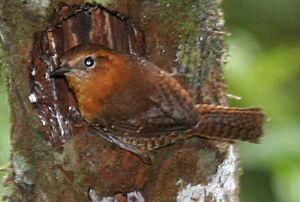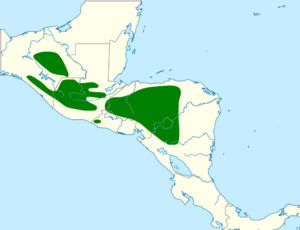Rufous-browed wren facts for kids
Quick facts for kids Rufous-browed wren |
|
|---|---|
 |
|
| Conservation status | |
| Scientific classification | |
| Genus: |
Troglodytes
|
| Species: |
rufociliatus
|
 |
|
The rufous-browed wren (scientific name: Troglodytes rufociliatus) is a small bird. It belongs to the Troglodytidae family, which includes all wrens. You can find this bird in Central America. Its home stretches from Mexico all the way south to Nicaragua.
Contents
What is a Rufous-Browed Wren?
Scientists once thought the rufous-browed wren was the same species as the mountain wren. But new studies looking at their DNA showed they are different birds. This wren has four main types, called subspecies. Each subspecies has slight differences.
The main subspecies is called Troglodytes rufociliatus rufociliatus. The other three are T. r. chiapensis, T. r. nannoides, and T. r. rehni.
What Does the Rufous-Browed Wren Look Like?
This little bird is about 10 to 11.5 centimeters (4 to 4.5 inches) long. It weighs around 11 grams (0.4 ounces). That's about as much as a few paper clips!
Both male and female rufous-browed wrens look similar. The main subspecies has a dark brown head, back, and rump. Its tail is a warm brown color. Both its back and tail have dark stripes. They have a light, creamy stripe above their eyes. This stripe is called a supercilium. Their cheeks are a darker brown.
Their chin is a light, creamy color. Their throat and chest are yellowish-cream. This color is darker on the sides. The lower part of their belly has stripes. Other subspecies have small color differences. For example, some might be darker or have more reddish-brown feathers.
Where Do Rufous-Browed Wrens Live?
Each subspecies of the rufous-browed wren lives in a specific area.
- T. r. chiapensis lives in the mountains of Chiapas, in southern Mexico. This is the most northern group.
- The main subspecies, T. r. rufociliatus, lives in central and southern Guatemala. It also lives in northern El Salvador.
- T. r. nannoides is only found near the Santa Ana Volcano in western El Salvador.
- T. r. rehni lives in Honduras and northwestern Nicaragua.
These wrens like to live in humid mountain forests. They can be found at high elevations. In Guatemala, they live from 1,700 to 3,500 meters (5,600 to 11,500 feet) high. In Nicaragua, they can be found as low as 1,250 meters (4,100 feet).
How Rufous-Browed Wrens Behave
What Do Rufous-Browed Wrens Eat?
Rufous-browed wrens usually look for food in pairs. They often search close to the ground. They like to hide in thick plants. They also look for food in plants that grow on other plants, called epiphytes. We know they eat caterpillars. But scientists are still learning more about their full diet.
Reproduction and Life Cycle
The nesting season for these wrens seems to be from late April to early July. Only a few nests have been found, all in Guatemala. Their nests are shaped like cups. They are made from dry grass and pine needles. Two nests were found inside holes in tree stumps. One nest was in a hole in the ground.
Only the female bird sits on the eggs to keep them warm. This is called incubation. What's interesting is that the male sometimes brings food to the female while she is on the nest. This is not very common for wrens.
What Do Rufous-Browed Wrens Sound Like?
The song of the rufous-browed wren is a mix of sounds. It's described as a "scratchy warble" that turns into a "tinkling trill." Their call is a loud, nasal "zhweet!"
Conservation Status
The IUCN (International Union for Conservation of Nature) has looked at the rufous-browed wren. They have listed it as a species of "Least Concern." This means it is not currently in danger of disappearing. Even though it lives in a somewhat small area, it is common in many places where its forest home is still healthy.


